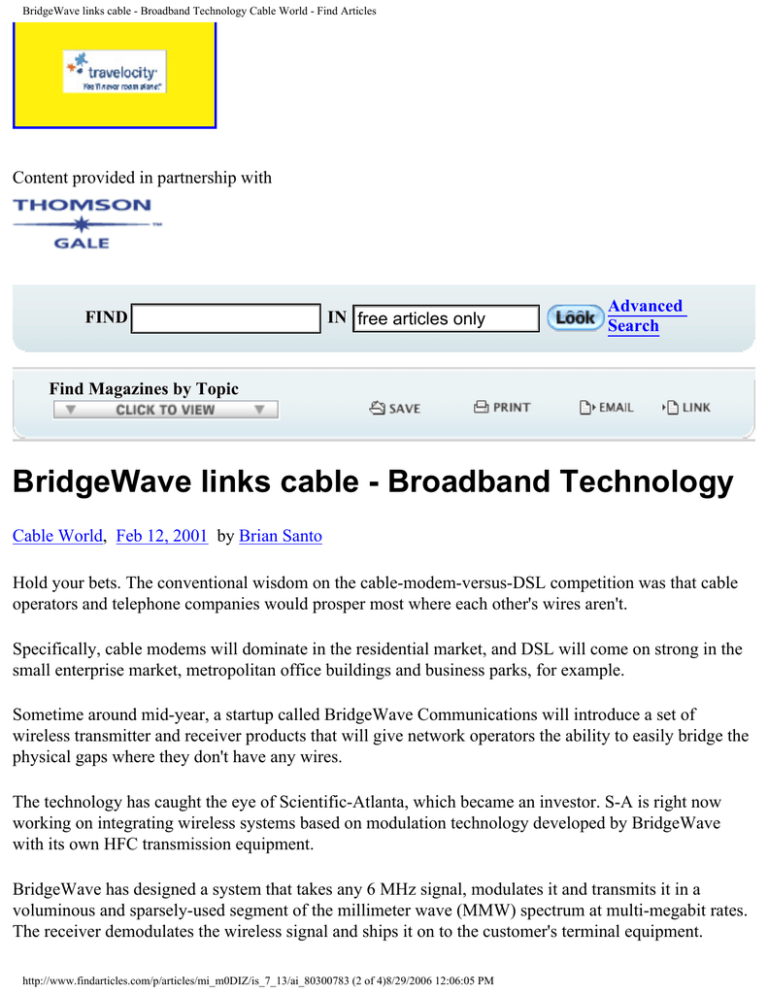
BridgeWave links cable - Broadband Technology Cable World - Find Articles
Content provided in partnership with
FIND
IN free articles only
Advanced
Search
Find Magazines by Topic
BridgeWave links cable - Broadband Technology
Cable World, Feb 12, 2001 by Brian Santo
Hold your bets. The conventional wisdom on the cable-modem-versus-DSL competition was that cable
operators and telephone companies would prosper most where each other's wires aren't.
Specifically, cable modems will dominate in the residential market, and DSL will come on strong in the
small enterprise market, metropolitan office buildings and business parks, for example.
Sometime around mid-year, a startup called BridgeWave Communications will introduce a set of
wireless transmitter and receiver products that will give network operators the ability to easily bridge the
physical gaps where they don't have any wires.
The technology has caught the eye of Scientific-Atlanta, which became an investor. S-A is right now
working on integrating wireless systems based on modulation technology developed by BridgeWave
with its own HFC transmission equipment.
BridgeWave has designed a system that takes any 6 MHz signal, modulates it and transmits it in a
voluminous and sparsely-used segment of the millimeter wave (MMW) spectrum at multi-megabit rates.
The receiver demodulates the wireless signal and ships it on to the customer's terminal equipment.
http://www.findarticles.com/p/articles/mi_m0DIZ/is_7_13/ai_80300783 (2 of 4)8/29/2006 12:06:05 PM
BridgeWave links cable - Broadband Technology Cable World - Find Articles
Advertisement
BridgeWave wants network operators to learn to treat wireless not as a technology unto itself, but as just
another transmission medium to be used in any network where it makes sense to do so.
BridgeWave's SCM technology is fully transparent to DOCSIS cable data traffic that's deployed over
our HFC transmission equipment, said Paul Connolly, VP-marketing and network architectures at
Scientific-Atlanta. This will enable MSOs to extend their networks to reach profitable subscribers
located beyond the reach of their existing deployments.
That's the key to BridgeWave's business model. Millimeter wave transmission is expensive. MMW
systems incorporate ICs made from gallium arsenide, which is more costly than silicon, and the chip
packages are more expensive, too. Today, most MMW transmitters come in at $5,000 to $10,000 each.
BridgeWave plans to bring costs down, perhaps to $3,000 per system or lower. That's still expensive
compared with coax or copper pair.
"If wire exists and it can deliver broadband rates, wireless loses," says Gregg Levin, BridgeWave's VPmarketing. "We won't compete head-on. We're looking to be a complement. For cable modems, that
means helping to get them into business parks. For DSL, that means getting them to whoever is too
distant from the central office," he says.
In the $3,000-per-unit price range, however, the economics work if you can spread that cost across a
small handful of users in, for example, a business park. A single receiver can be connected to multiple
cable modems. "This changes the model," Levin says. "Pipes and plumbing become just a commodity.
Service now becomes important. The drive to combine different media will get you the high-mileage
subscribers everyone is after," he says.
COPYRIGHT 2001 Copyright by Media Central Inc., A PRIMEDIA Company. All rights reserved.
COPYRIGHT 2003 Gale Group
1 - 2 - Next
Find Featured Titles for: Sports
Advertisement
http://www.findarticles.com/p/articles/mi_m0DIZ/is_7_13/ai_80300783 (3 of 4)8/29/2006 12:06:05 PM



